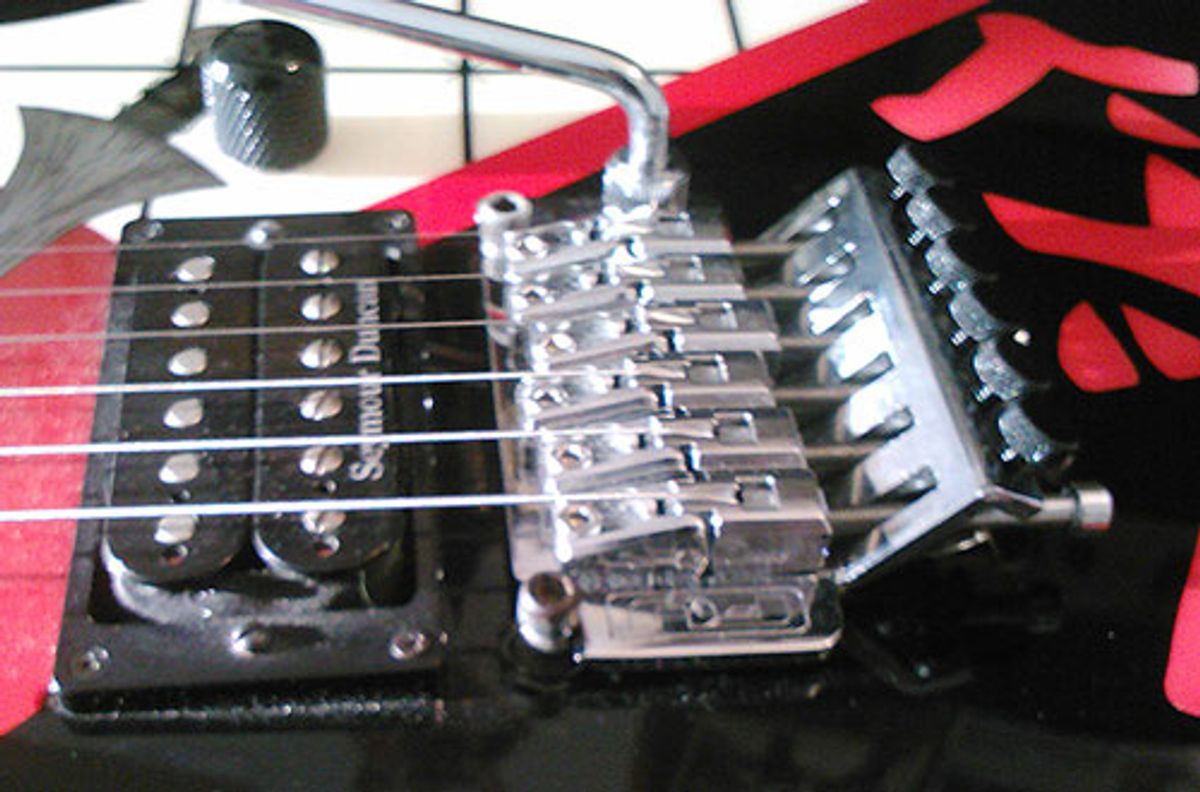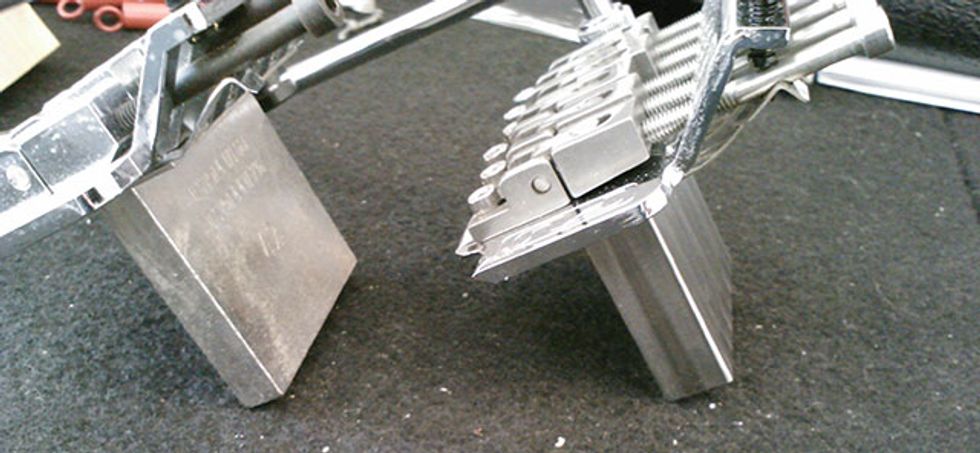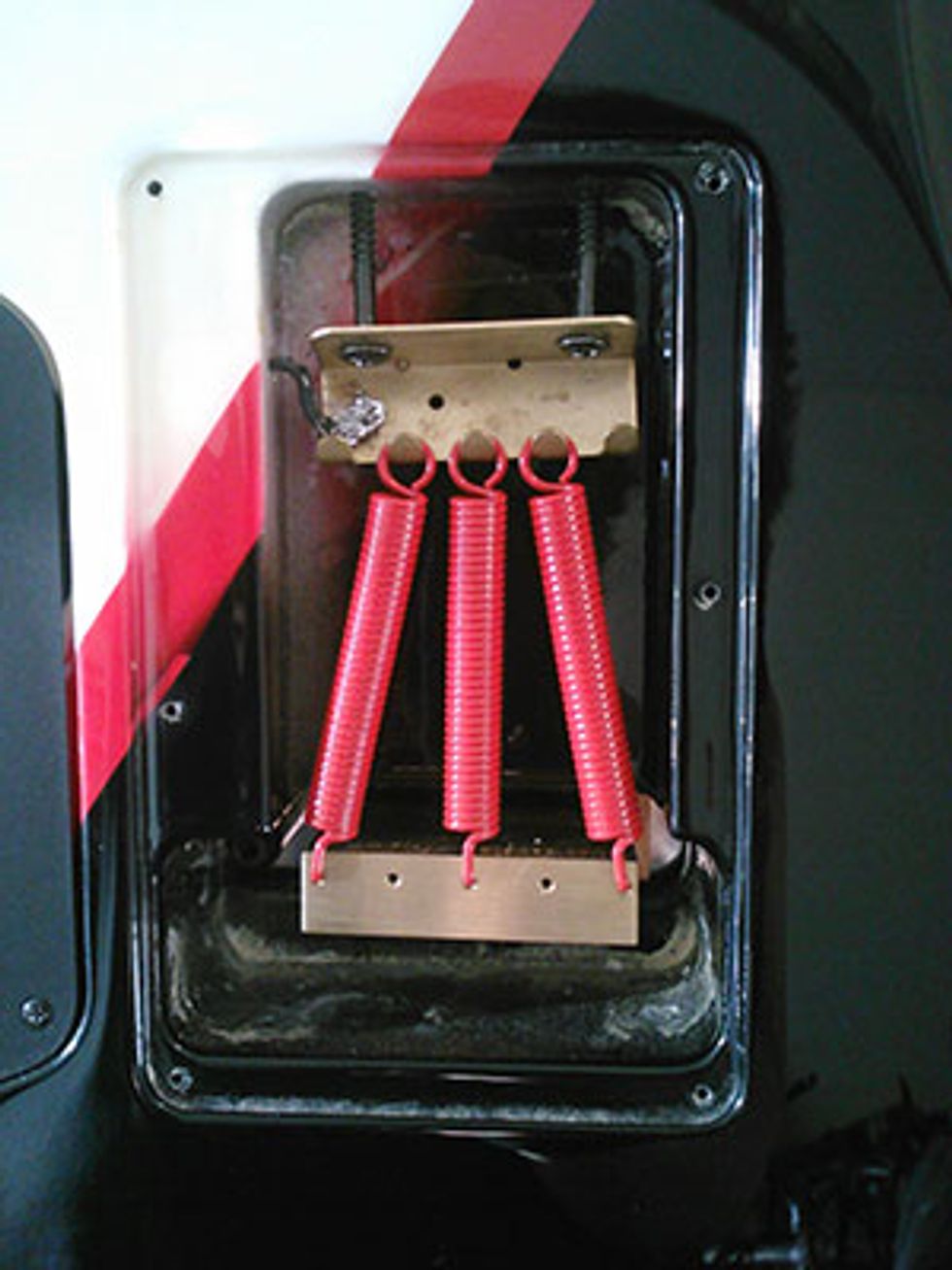
By using stainless steel and titanium in critical parts of the unit, FU-Tone has indeed taken the Floyd Rose concept in several new directions.
After building a better mousetrap, Adam Reiver of FU-Tone.com (formerly Floyd Upgrades) decided to build an even better mousetrap. Back in 2009, we reviewed the Big Block upgrade, a Floyd Rose tremolo replacement sustain block that is substantially larger and more massive than the standard Floyd Rose block. It represented a big improvement, but Reiver figured he could find more ways to improve on the existing Floyd Rose design. And by using stainless steel and titanium in critical parts of the unit, he has indeed taken the Floyd Rose concept in several new directions. Already such players as Warren DeMartini, Steve Stevens, Phil Collen, Slash, George Lynch, and Alex Lifeson have embraced the potential of these upgrades.
Stepping Off
The standard Original Floyd Rose (OFR) bridge was built with a steel baseplate, steel saddles with steel inserts, a metal spring claw, steel springs, and a thin nickel-plated brass sustain block.
Reiver’s improvements begin with two high-performance bridges. Each features steel baseplates that are very similar to the OFR baseplate in dimension, but things change fast from there. The more basic and affordable upgrade package includes stainless steel hardware (string locking screws and saddle mounting screws), but also features titanium saddle inserts, noiseless springs, a brass spring claw, and a brass Big Block sustain block. The more technically advanced and expensive version includes the same stainless steel hardware, but with a titanium block, titanium saddles with titanium inserts, a brass spring claw, and heavy-duty noiseless springs.
Stainless steel hardware is critical in Reiver’s designs for more than aesthetic reasons. Steel components are susceptible to moisture-driven corrosion—a problem that plagues the standard hardware on frequently used OFRs that are exposed to acidic sweat or the occasional beer soak. The structural integrity of titanium is a step beyond stainless steel, of course, as it verges on indestructible.
Original Floyd Rose (left) and High Performance Bridge Full Titanium upgrade (right).
Mass is also a critical and fundamental difference between the FU-Tone.com versions and the originals. While the OFR bridge weighs exactly 1 pound, the other two have drastic weight differences. The brass block version weighs in at 1.25 pounds, and the titanium block version is an amazingly light 14 ounces.
The durability and in some cases, weight advantages of these materials is beyond question, but the tonal differences can be less easy to pinpoint. And what really makes these components sonic upgrades is the way they work together.
More Boom Through Bulk
Our test guitar for this review is a pre-Fender-era Charvel with a single Seymour Duncan JB pickup. It was originally equipped with a top-mounted, non-recessed floating Floyd Rose with a 42 mm sustain block.
The brass block FU-Tone bridge was the first version I checked out. Removal and changeover included replacing the pot-metal spring claw and steel springs. And after replacing the spring claw with the new brass one, I installed the bridge into the cavity and hooked the noiseless springs into place.
Stringing up, there is a noticeable difference in the feel of clamping the strings with the titanium inserts via the stainless steel locking screws. The titanium inserts can withstand up to 140,000 pounds of pressure, while the OFR inserts have always been prone to deforming, expanding, or breaking under the pressure of the locking screw. In these respects, the titanium inserts are a vast improvement, insuring against structural mishap, and they hold the string firmly from accidental slippage. Very little effort was needed to tighten the lock screw when clamping the strings into the saddles securely.
Once the guitar was strung up, intonated, and tuned, the it sounded richer, deeper and capable of more sustain. The OFR sustain block has been known to contribute to thin tone, but the brass block FU-Tone bridge gave the Charvel a much needed boost in midrange resonance. You can also hear tighter definition and focus in individual notes and greater clarity in chords. And with the noiseless, polymer-coated springs, there was no creaking, squeaking, or any ghost resonance.
After playing for several hours with this setup, I removed the brass block rig and switched in the titanium unit. As part of the upgrade, I also replaced the noiseless springs with the heavy-duty noiseless springs. Coated in a bright red polymer, these springs have a much higher tension than common tremolo springs. While installing the bridge, hooking the springs onto the titanium sustain block required loosening the brass spring claw a considerable amount, and it’s easy to imagine that this increased tension would enhance the transfer of vibration from the block to the body. The clamping inserts inside the titanium saddles are cylindrical and almost twice the size of the standard Floyd Rose saddle insert, and they force the string to stay centered inside the saddle.
Noiseless springs on the FU-tone brass package.
Ratings
Pros: The brass package increases tonal capabilities and unlocks characteristics that might be hidden in a locking tremolo-equipped guitar. The titanium package offers structural indestructibility while giving the guitar a much more aggressive attack in tone.
Cons: The titanium block may give a guitar a harsh brittle-tone to a common wood like alder.
Tones:
Ease of Use:
Build/Design:
Value:
Street:
Standard Upgrade Package $319
Full Titanium Package $922
Once the guitar was properly intonated and tuned, the tones were crisp with more presence. In overdriven settings, there was a much more aggressive attack that, at times, bordered on harshness. Lowering the gain on the amp alleviated most of that problem. Still, the tone generated via the titanium block seemed brittle at extreme settings compared to the brass unit or the original. Sustain was still excellent, though in general, there was less physically perceptible resonance. Also, when reaching for the arm to vibrato chords or to do extreme pitch bends, I found the heavy-duty noiseless springs made the action of the bridge much stiffer.
The sonic properties of the titanium version can vary from guitar to guitar. And when installed in a solid mahogany Charvel Natural Series, the titanium block FU-Tone bridge balanced the dark tonal characteristics of the mahogany with the added presence derived from the titanium bridge, and the guitar sounded much more alive than it did with its stock OFR. Indeed, the FU-Tone.com titanium components were what this guitar needed to produce tones beyond the low-to-midrange voice it was born with.
The Verdict
FU-Tone brass and titanium block tremolos with stainless steel hardware
have much to offer. And both have the capacity to summon the hidden
tones in a locking tremolo guitar, depending on the wood. The brass
version with stainless steel hardware and titanium inserts seems like
the most versatile package. The titanium version was more useful in a
darker-sounding guitar, as it can add a lively presence to a
fundamentally warm instrument.
It’s surprising to hear how much tonal difference you can derive from otherwise invisible components like the stainless spring claw and noiseless springs, and there’s a lot to be said for stainless steel’s longevity.
FU-Tone.com offers each component separately, so you can assemble your own system to suit your specific guitar and sonic needs—a real benefit. And whether you go for a drastic tone shift or a subtle one, you’ll be surprised at what you can achieve with parts you might otherwise have overlooked.



